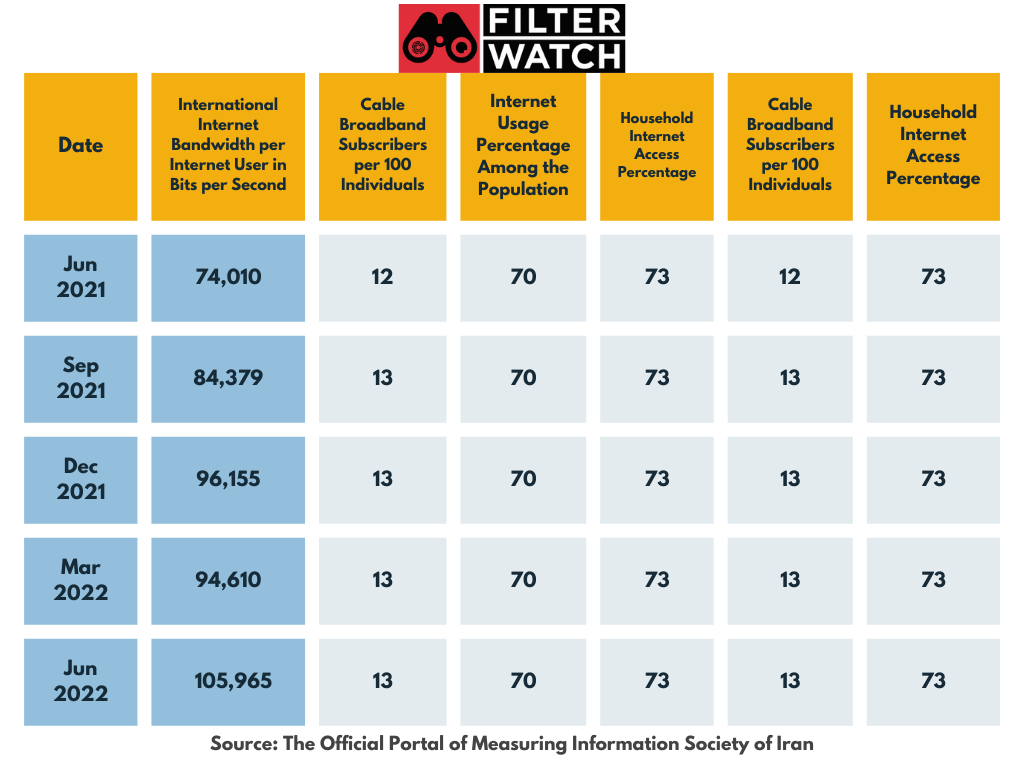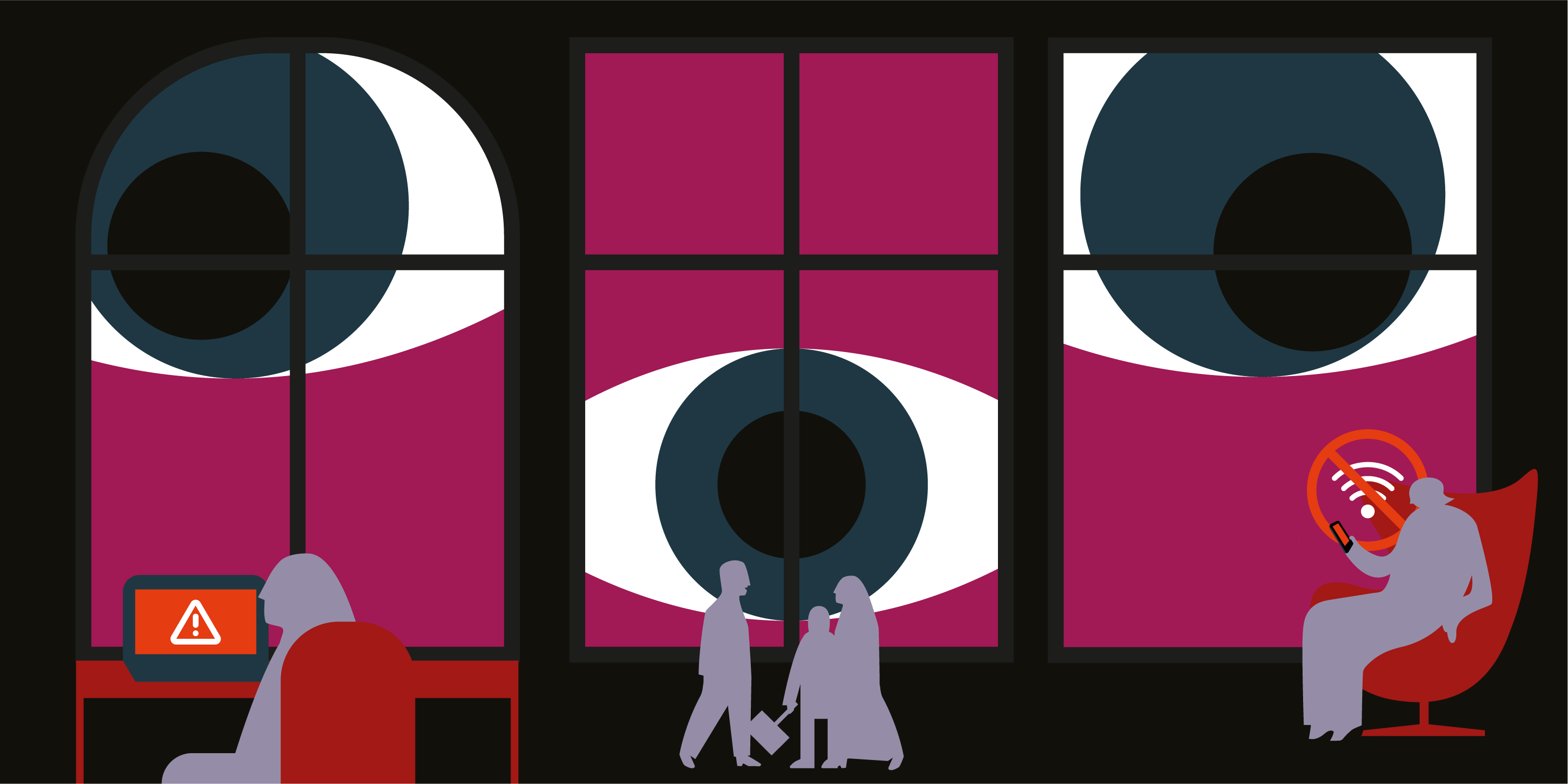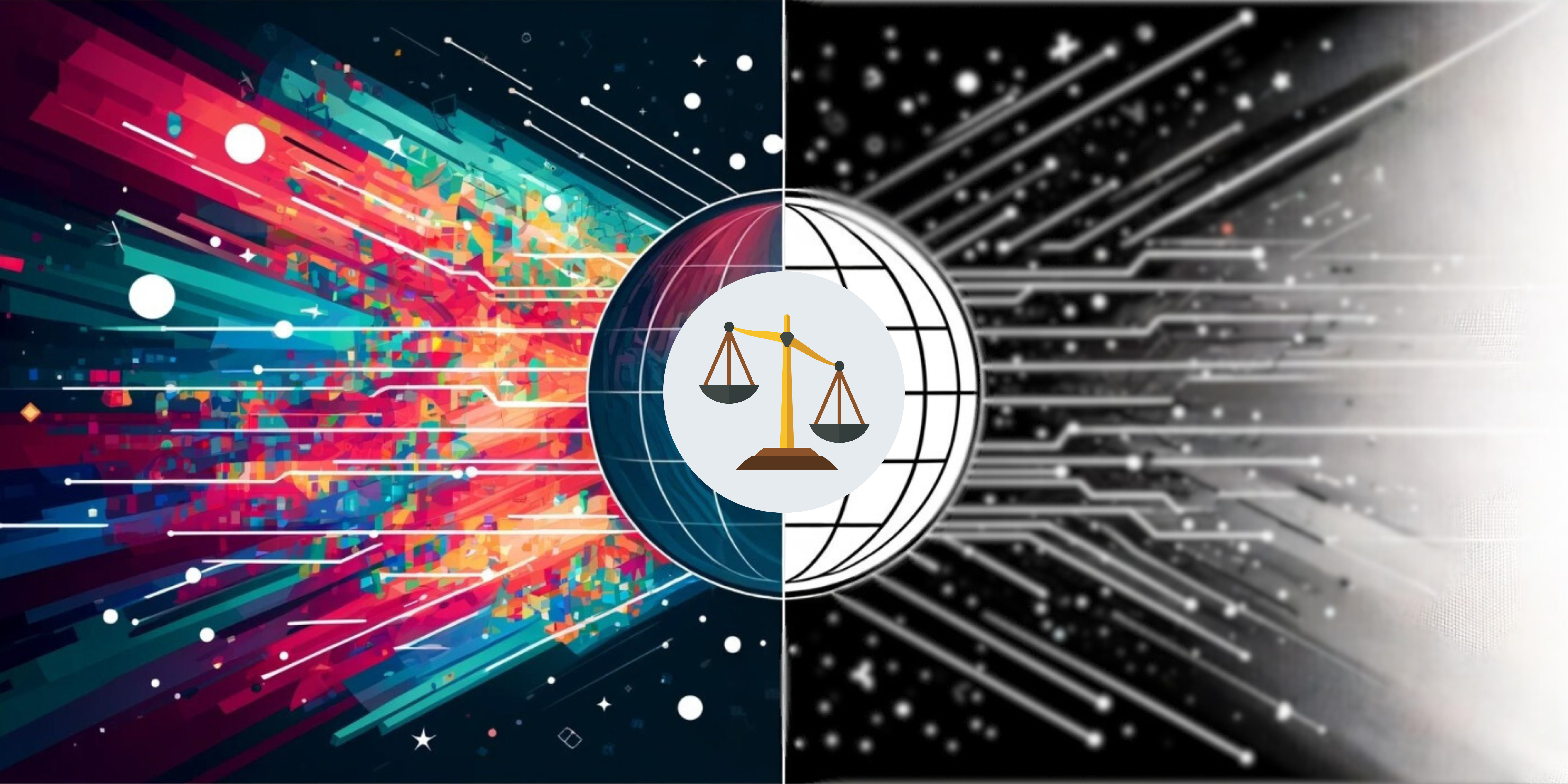Summary Of Analysis
Filterwatch’s findings reveal that the Islamic Republic of Iran is intensifying its hold on internet control and restrictions, adopting faster and more clandestine approaches. This pattern persists, continuing for eight months after the initial outbreak of protests following the death of Mahsa Jina Amini. As a result, conventional censorship methods, filtering, and possibly even internet shutdowns will become irrelevant in the months and years ahead.
These policies include:
- Significant Reduction in Global Internet Bandwidth
- Implementation of a Layered Internet System
- Revocation of Public Oversight over Supreme Council of Cyberspace’s Decisions
- Significant Increase in Internet Prices
- Internet User Authentication Mechanism
In the past, analysts and observers examining Iran’s Internet landscape commonly speculated on the possibility of the Islamic Republic implementing a complete blackout of the Internet as a worst-case scenario. However, this perspective encountered resistance from those who contended that the government’s dependence on the Internet for critical services made such an action impractical.
Regardless of these varying analyses, examining recent developments reveals a distinct trend. While certain policies were initiated before the “Woman, Life, Freedom” movement, there is a discernible pattern of accelerated implementation and reinforcement of these policies following the movement. The collection of these policies unmistakably indicates that the authorities of the Islamic Republic are pursuing a far more intricate objective beyond mere censorship or even a complete Internet shutdown – namely, the complete isolation of Iran from the global Internet network.
The implementation of these policies becomes evident through the escalation of filtering measures, a significant reduction of bandwidth for popular non-Iranian platforms, and a profound decrease in global Internet network bandwidth. Additionally, there has been an increase in international traffic tariffs, the expansion of authoritarian practices beyond the Internet network, such as mandatory hijab enforcement, stringent control over domestic and foreign content, and the establishment of a layered Internet system.
Apart from these measures, the surge in Internet costs has led users to avoid updating their applications and software, thereby heightening their exposure to security threats. Furthermore, within the Iranian population, individuals from low-income backgrounds are more inclined to have limited access to filtering and censorship tools due to their associated expenses.
According to the most recent statistics released by the Islamic Parliament (Majlis) Research Center in May 2023, there has been an approximate increase of 11 million people living below the poverty line over the past decade.
Essentially, Iran is transitioning from a conventional authoritarian regime to a form of digital authoritarianism.
Countdown to the Dwindling of International Internet Bandwidth: Anticipating a 90% Reduction
On May 20, 2023, Iran’s Minister of Information and Communications Technology, Issa Zarepour, stated that the country’s maximum international bandwidth need is less than ten percent. Zarepour made this announcement during a cabinet meeting, mentioning that 90% of the country’s needs can be fulfilled domestically. He also emphasized the “maturity” of local platforms, suggesting that they are capable of accommodating users effectively.
This indicates that the Ministry of Information and Communications Technology aims to significantly reduce Iran’s reliance on global Internet bandwidth by 90%. This objective aligns with the provisions outlined in the Cyberspace Service Regulation System Act, and it is in line with the broader goals of the National Information Network to enhance internal platforms and infrastructure.
The Impact of Iran’s Seventh Development Plan on Broadband Connectivity
In the seventh development program bill, published in May 2022, there is a provision addressing the reduction of global bandwidth in favor of domestic bandwidth.
Clause 19 of this plan mandates the Ministry of Information and Communications Technology, in collaboration with the National Center for Cyberspace, to establish a new tariff structure with the aim of attaining a 70% portion of domestic internet traffic. This provision is anticipated to result in higher costs and slower internet speeds. The inclusion of this aspect in the bill aligns with the implementation of a specific component of The master plan and architecture of the National Information Network However, Zarepour revealed in an interview with the Karang website on May 29, 2023, that this specific clause had been removed. He said the reason for its exclusion was that “the percentage should not be explicitly mentioned in the development plan.”
According to sections 1-4-2-2 of The master plan and architecture of the National Information Network approved in 2020, the government must establish a 70:30 ratio between domestic and international BAS (Basic Application Services) on internet traffic. Additionally, it is anticipated that each year the domestic proportion will increase by 15% while the international proportion will decrease accordingly. By implementing this regulation, the intention is to gradually reduce the traffic share of foreign platforms to zero within three years.
In the third year since the approval of this decree, which stipulates that domestic traffic should account for 70% of internet traffic, the Minister of Information and Communications Technology discusses a significant 90% decrease in the country’s international bandwidth at this particular juncture.
It should be noted that there is a lack of precise statistics regarding the volume of domestic and foreign traffic utilized by Iranian users. This information is kept confidential or accessible only to a limited number of Internet service providers, making it challenging to obtain accurate data.
On May 9, 2023, Amir Mojiry, an Iranian digital rights activist committed to holding the government accountable and promoting transparency in internet policies by submitting requests for information through the government’s transparency system, shared a tweet on his Twitter account. He highlighted that “along with the secrecy surrounding the international traffic statistics of the country, the traffic data related to Iranian messaging applications is also confidential.” He wrote, “Various officials have provided statistics indicating a significant increase in the number of monthly active users for apps like Bale, Eitaa, and Soroush, ranging from four to twelve times throughout one and a half years. The user base of Rubika has reached 40 million”.
Mojiri’s assertion that this information was confidential stemmed from his request on May 1, 2023, through the government’s information transparency portal.
This Iranian individual sought information from the Telecommunication Infrastructure Company (TIC), which serves as Iran’s Internet input-output gateway, regarding the amount of global Internet traffic consumed by Iranian citizens in the past seven months. The company replied: “As the requested information is confidential, visit the Ministry of Information and Communications Technology’s security office with your identification card.”
The most recent data regarding the internet traffic consumed by Iranian citizens comes from an announcement made by Davood Zareian, the vice president of commercial and customer services at the Telecommunication Company of Iran (TCI), during a conversation on Clubhouse on April 18, 2022. According to his statement, the ratio of foreign to domestic internet usage among this operator’s users is approximately 70 to 30, demonstrating a significant majority of people still favor foreign over domestic platforms and services. Contrary to the statement mentioned above, a careful examination and comparison of the report from TIC reveal that the international internet bandwidth is actually significantly lower than it was in the past.
Based on the statistics provided by the Communications Regulatory Authority of Iran, the penetration rate of Fixed broadband bandwidth experienced a decrease of 0.76% during the winter of 2023 compared to the same period in 2022.
However, there has been a reduction in the count of Fixed broadband subscribers who have access to improved internet speeds and greater bandwidth enabled by optical fiber technology. In contrast, the number of mobile internet users has been on the rise, aligning with the government’s policies focused on monitoring and regulating the population.
Bandwidth Reduction as an Alternative Approach to Internet Filtering
It appears that in response to the shortcomings of the conventional internet filtering policy in Iran, the authorities are now exploring alternative methods such as reducing bandwidth and increasing internet costs as a means to exert control, potentially replacing or supplementing the practice of internet filtering and even resorting to complete shutdowns in certain instances.
Earlier attempts were made to encourage users to shift towards domestic platforms by implementing strategies like segregating domestic and foreign internet traffic and reducing the cost of internal traffic.
In a previous instance, a similar approach to reducing bandwidth instead of outright filtering was employed on a smaller scale in the case of the Viber messenger in Iran. Back in 2014, although the messaging application was not officially blocked, the available bandwidth was substantially limited, rendering the application practically unusable for users attempting to establish connections.
An assessment and analysis of Iran’s internet policies, which encompass bandwidth reduction and price increases, suggest that the authorities intend to encourage the usage of domestic products and services, at the expense of compromising user security. Furthermore, the implementation of higher prices and bandwidth restrictions serves as a method to limit access to the global network and hinder the effectiveness of Internet censorship circumvention tools.
Three-Year Strategy for Eliminating International Bandwidth
In Iran, the reduction of international bandwidth is supported by two fundamental mechanisms: the Cyberspace Service Regulation System Act and the National Information Network’s “master engineering design.” These frameworks serve to legitimize and provide a legal basis for implementing policies that result in the reduction of international internet bandwidth within the country.
Chapter Seven of the Cyberspace Service Regulation System Act addresses penalties for foreign platforms that violate regulations. One such penalty is implementing an internet traffic policy, where a distinct tariff is applied to the platform in question. This means that if a foreign platform violates regulations, the government has the authority to set a traffic cost for using that platform that can be significantly higher, such as five times the cost of internal traffic.
Irrespective of any violations, the government’s overarching plan involves gradually reducing foreign bandwidth compared to domestic bandwidth over time. As outlined in sections 1-4-2-2 of the National Information Network’s “master engineering design,” a specified ratio or share of 70:30 for domestic to foreign service traffic exists. This ratio is intended to increase annually by 15%. Consequently, if such a law is implemented, the traffic share of foreign platforms would diminish to zero within three years.
This issue holds significance as it is considered more effective than conventional filtering methods in blocking access to content that the government does not approve.
When a website or application is blocked using a filter that relies on global traffic, other methods are still available for accessing the content, such as using circumvention tools. However, suppose the international traffic has been significantly reduced or restricted to the point of reaching zero. In that case, the effectiveness of these circumvention tools diminishes, as there is essentially no substantial internet access outside of the approved domestic platforms. In such cases, users may be compelled to resort to government-sanctioned VPNs or other domestic alternatives to access restricted content.
If this process is implemented, global service traffic will gradually diminish over three years, eventually reaching zero and rendering them virtually inaccessible.
In such a scenario, the government could exercise control over a specific segment of the population’s access to the global Internet according to its desired pattern by implementing a layered internet system. This would enable the government to maintain surveillance and monitoring capabilities while also potentially reaping significant financial benefits. While initially an ambitious concept, the layered internet system is presently being piloted and may be expanded on a larger scale in the future.
Revocation of Public Oversight over the Supreme Council of Cyberspace’s Decisions
On May 23, 2022, Iran’s President Ebrahim Raisi announced a modification to the law titled “Amendment of the Law on Organizations and Procedures of the Administrative Court of Justice.” As per Article 12 of this amendment, the Administrative Court of Justice no longer possesses the authority to review the approvals made by the Supreme Council of Cyberspace.
Implementing such a law grants the Supreme Council of Cyberspace greater autonomy in implementing desired policies and laws without requiring parliamentary approval or allowing individuals to lodge complaints against the council’s decisions. This effectively allows the council to exercise its authority and enforce government-endorsed policies without significant external scrutiny or checks and balances.
With the amendment to this law, formally notified on May 23, 2022, and signed by Ebrahim Raisi, the implementation of restrictions will indeed become expedited. The approval of policies that result in user limitations can be directly enforced without legal interference or the requirement to pass through the parliament or the Guardian Council. Although they may not be referred to as “laws” in a strictly legal sense, under the new circumstances, these policies will carry similar weight and authority as laws.
According to the amendment made to Article 12 of the Law on Organizations and Procedures of the Administrative Court of Justice, “a new Note 2 is added, and the numbering of the note in the said Article is changed to one. The note specifies that the Supreme Council of the Cultural Revolution and the Supreme Council of Cyberspace are exempt from the jurisdiction of this article. However, the Administrative Court of Justice retains jurisdiction over handling the approvals and decisions made by sub-groups of these councils, such as boards, working groups, committees, and headquarters.”
Implementation of a Layered Internet System as a Measure Against Circumvention Tools
The implementation of a layered Internet system serves as another approach to enforce policies aimed at reducing international bandwidth, gradually replacing the reliance on traditional filtering methods. Circumvention tools have constantly challenged the Iranian government as they engage in a cat-and-mouse game. Despite significant efforts and resources dedicated to blocking these tools, circumvention tools’ popularity persists because many popular services are filtered. As a result, a considerable portion of Iran’s international traffic is transmitted through these circumvention tools.
The Iranian authorities have developed a belief that in order to put an end to the ongoing cat-and-mouse game with circumvention tools, they must gain control over the market for such tools.
The “Legal VPN” project was introduced on November 21, 2019, as a technical solution to address internet connectivity issues arising from the events in November 2019, known as Bloody November. This project aimed to provide a classified or layered approach to internet access, potentially offering a sanctioned and regulated virtual private network (VPN) solution.
In September of that year, Mohammad-Javad Azari Jahromi, the Minister of Information and Communications Technology during Hassan Rouhani’s second administration, presented a proposal for a class or layered access to the internet to the Majlis (Iranian Parliament).
Azari Jahromi highlighted the challenges of circumvention tools and emphasized the need for a comprehensive plan to address this issue. He stressed the importance of organizing different access levels, stating, “It would be unreasonable to treat internet access for professionals like doctors, university professors, or journalists on the same level as that of an eight or nine-year-old child.”
As a result, the proposal to implement an internet access plan based on social class was put forward as an alternative strategy to address the challenges associated with circumvention tools. This plan aimed to control the market for such tools and regulate access to internet content. Iranian authorities continue to emphasize this approach’s importance in managing and regulating internet usage in the country.
As an illustration, during the National Information Network Capacity Conference at the ICT Research Institute on July 28, 2022, Zarepour emphasized the importance of reducing reliance on circumvention tools and services. Zarepour expressed the objective of ensuring people’s requirements are adequately addressed without the need for such tools.
Increment in Internet Prices
As part of their strategy to encourage domestic usage and promote the National Information Network (intranet), the Iranian authorities have implemented several policies. In addition to gradually decreasing bandwidth and categorizing the Internet, they have also raised the cost of Internet services, particularly international traffic. This measure is designed to exert pressure on users, compelling them to opt for the intranet and prioritize domestic traffic.
Since the inauguration of Ebrahim Raisi’s government, the price of Internet services abruptly doubled once in March 2022, catching users by surprise due to the lack of prior notification. Interestingly, in an interview on March 22, 2022, the Minister of Information and Communications Technology assured that any revisions to Internet tariffs would be carried out without imposing undue pressure on the public.
During a cabinet meeting on May 10, 2023, Zarepour addressed the issue of Internet price hikes once again, echoing similar statements. On the meeting’s sidelines, he emphasized that the objective was not to burden the public with increased costs. Instead, Zarepour highlighted the importance of telecommunication operators making essential investments to enhance service quality.
The Iranian authorities have implemented price hikes for Internet services, particularly international traffic, for two years. Interestingly, discussions about investing in Internet development are taking place despite statistics and information published on the website of The Official Portal of Measuring Information Society of Iran, which operates under the supervision of the Ministry of Information and Communications Technology. These statistics reveal that Internet bandwidth has shown little significant difference between May 2021 (the final three months of Hassan Rouhani’s government) and May 2022 (the latest data available during Ibrahim Raisi’s government). Moreover, there has been a lack of noticeable changes across most indicators.

Notwithstanding the data mentioned above, as highlighted in the section on the seventh development plan, the Iranian government has designated the traffic statistics of Iranian users as confidential.
The prevailing circumstances have led to strong objections from Iranian citizens regarding the state of the Internet. A notable example is Ali Sharifi Zarchi, a bioinformatics and artificial intelligence faculty member at the Sharif University of Technology, Faculty of Computer Engineering. On May 17, 2023, Zarchi took to his Twitter account and addressed Zarepour, referring to him as the “Minister of Communications Obstruction,” to express his dissatisfaction with the inadequate internet speed, bandwidth, and accessibility. Zarchi accused the minister’s policies of betraying the future of Iran and suggested that “a transparent survey among students, academic professionals, startups, and entrepreneurs would reveal that the Internet restrictions, which function as an accompaniment to sanctions, have become a major driving force behind emigration from Iran.”
Internet User Authentication Mechanism
According to Article 285 of the 7th development program, the National Organization for Civil Registration of Iran is mandated to establish a framework known as the “national identity database of individuals and legal entities.” This system aims to facilitate the identification of familial connections, ancestral relationships, and the overall identification of individuals within their respective families.
The mentioned program mandates the National Organization for Civil Registration of Iran, in collaboration with the National Center of Cyberspace, to establish a mechanism for authentication when delivering electronic services across both public and private sectors.
By leveraging the capabilities of such a database, the government’s objective of imposing restrictions on internet access, known as a layered internet system, can be more readily attained. In a layered internet system, individuals undergo authentication and subsequently gain access to specific segments of the internet depending on their social status and occupation.




